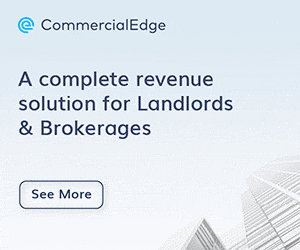
The Complete Guide to Commercial Lease Types

The landlord-tenant relationship is a complex arrangement based on a wide range of terms incorporated in the commercial lease. When it comes to commercial real estate (CRE), both parties must thoroughly evaluate the conditions of the agreement in order to make well-informed decisions and choose the lease that best fits their business goals amid the rapidly shifting CRE marketplace.
While every lease is negotiable and there are no absolute rules, there are eight main types of CRE leases. Each lease type involves a series of terms that require careful consideration from both the landlord and the tenant. For example, which party will be responsible for paying utilities? What about property taxes and insurance? Below is a list of the principal lease categories and an overview of what each type entails.
Types of CRE Leases: From Gross to Graduated
Full-Service/Gross Lease
In a full-service lease, also known as a gross lease, the landlord bears all operating expenses related to the space the tenant occupies. The tenant is only responsible for paying the base rent. Operating expenses include property taxes, insurance on the building itself and common area maintenance costs (also known as CAM charges).
From the tenant’s perspective, a full-service lease is typically the most straightforward and easy type to budget: the tenant only pays a single, flat amount in rental fees. However, gross leases usually involve a higher rental rate, as the landlord is responsible for paying all incidental costs from the rental fees.
While the specifics of each full-service lease vary, some may include a provision to limit the expenses the landlord is required to pay. For instance, depending on the lease terms, if the operating costs exceed the predetermined cap, the tenant is responsible for paying any additional expenses.
Modified Gross Lease
A modified gross lease allows the landlord and tenant to negotiate which utilities will be covered by which party. A compromise between a full-service lease and a net lease (more on that below), the modified gross lease is one of the most common types of lease agreements.
Depending on agreed-upon terms, a tenant will still pay a single lump sum for the base rent in a modified gross lease, but they might also pay a portion of the operating costs. In this scenario, the landlord pays the remaining share of the operating expenses.
For example, a potential modified gross lease could entail that the tenant will pay the base rent and utilities for the first year, then pays a pro-rata share of operating costs each additional year. The pro-rata share would likely be defined as the percentage of the building or space the tenant occupies.
Net Lease
A net lease is the opposite of a full-service lease. It comes with a lower base rent and allocates the responsibility to cover a share of operating costs to the tenant. Under a net lease, the tenant pays a fixed rent in addition to a proportionate share of operating expenses.
This lease category includes four variations, depending on the number of operating costs the tenant covers: single net (“N” lease), double net (“NN” lease), triple net (“NNN” lease) and absolute net (also referred to as an absolute triple net lease).
- Single Net Lease
In a single net lease, the tenant is responsible for paying the base rent and one of the three primary operating costs associated with the leased space: property taxes, insurance on the building or maintenance costs. The landlord covers the remaining operating expenses. Single net leases have many variations but are generally an uncommon lease model.
- Double Net Lease
In a double net lease, the tenant covers two of the main operating costs. Since the tenant carries a share of the operating expenses, the landlord charges a lower base rent. In a typical double net lease, tenants are responsible for paying property taxes and building insurance, while the landlord covers the common area and maintenance costs.
- Triple Net Lease
In a triple net lease, the tenant pays all the operating costs in addition to their monthly rent. The landlord passes on the responsibility of covering all three “nets” (property taxes, building insurance and CAM charges) to the tenant on a pro-rata basis.
These lease agreements also involve a lower base rent and are usually long-term. NNN leases are the most popular lease type for free-standing, single-tenant buildings.
- Absolute Triple Net
An absolute lease or absolute triple net lease is sometimes incorrectly equated to a triple net lease. While there are some similarities between the two lease types, an absolute NNN lease relieves the landlord of all responsibility for operating costs, in any scenario.
Basically, the tenant owns the building without acquiring it and carries every risk related to ownership of the property, including construction or rebuilding expenses, should a catastrophic event occur. For example, tenants in an absolute NNN lease must pay rent even if the building is condemned.
These types of leases are much less common than standard NNN leases and are only applicable to single-tenant buildings. In these types of agreements, the renter is typically a credit tenant, such as a national or large regional tenant with excellent credit that can carry their own insurance. And unlike under other net leases where the landlord is reimbursed after paying the operating costs, the tenant is directly billed for the expenses in an absolute NNN lease.
Percentage Lease
A percentage lease is most often used in retail, and it requires the tenant to pay a fixed rent, as well as a percentage of monthly gross sales. Operating expenses are partially or completely the landlord’s responsibility.
This type of agreement typically involves a lower rental rate and a clause determining a revenue threshold known as the breakpoint. The tenant is only required to pay a percentage of their profits once they surpass said breakpoint. Consequently, the landlord is incentivized to provide a good location that creates ample foot traffic for the tenant.
Variable Lease
Variable lease agreements are subject to certain conditions that allow the landlord to increase rental payments based on agreed-upon terms. This category includes two sub-types: index leases and graduated leases.
- Index Lease
In an index lease, the base rental rate is tied to a predetermined index, most often the Consumer Price Index. Other indices can include local rental market figures or average rents as reported by industry groups, business media or governmental bureaus, among other options. For instance, an office tenant in a well-located downtown property may negotiate a yearly rent review according to the average office rental rate in the city.
- Graduated Lease
In a graduated lease, a predetermined schedule defines the rent increase, typically on an annual or seasonal basis. A standard graduated lease usually stipulates an incremental increase, which involves rent hikes on fixed dates. For example, a tenant may negotiate a yearly 3.5% rent increase to be charged every September.
The seasonal graduated lease is common for businesses relying on seasonal/tourist activities. This type of lease can stipulate a more expensive rental rate during the high season and adjusted, lower rates during the off-season.
| LEASE TYPE | WHAT THE TENANT PAYS | WHAT THE LANDLORD PAYS |
| Full-service/Gross lease | Base rent | Property taxes Building insurance Utilities and CAM charges |
| Modified gross lease | Base rent and utilities A portion of operating expenses | Utilities and the remaining share of operating expenses |
| Net lease | Base rent and utilities Fixed share of operating expenses | Any remaining operating expenses (if applicable) |
| Single net “N” lease | Base rent and utilities Property taxes | Building insurance Maintenance Repairs |
| Double net “NN” lease | Base rent and utilities Property taxes Building insurance | Maintenance Repairs |
| Triple net “NNN” lease | Base rent and utilities Property taxes Building insurance Certain maintenance expenses | Some building maintenance and/or repairs |
| Absolute NNN lease | All costs associated with the building | None |
| Percentage lease | Base rent Percentage of gross business sales | Property taxes Maintenance Insurance fees |
| Variable lease | Rental rate that changes over time | Depends on the lease terms |
The Impact of ASC 842 on Commercial Leases
FASB ASC 842, the new lease accounting standard, is changing the way leases are accounted for, regardless of the commercial lease type. Under the new standard, all leases with a term of at least 12 months must be recorded on the balance sheet.
Under the previous standard of ASC 840, leases were classified as capital or operating leases, but FASB’s new guidelines categorize a lease as either a finance or operating lease. Specifically, organizations are required to recognize all leases as assets and liabilities on the balance sheet.
While capital leases were already recorded on the balance sheet under the previous guidelines, operating leases — that were disclosed in financial statements — now must be recorded there as well. The new standard aims to increase transparency and comparability among lease obligations and simplify the lease accounting process.
Conclusions
While net leases are considered more landlord-favorable and full-service leases are more convenient from the tenant’s perspective, every CRE lease should involve a comprehensive negotiation process. The purpose of a successful lease should be to find a balance between each party’s obligations and interests so that the end result is an agreement that favors both the landlord and the tenant.
More Articles You Might Like
Walkable Urbanism to Drive Future Real Estate Development in the U.S.
The 2023 Foot Traffic Ahead report takes an in-depth look at walkable urban areas in the top 35 U.S. metros.
Global Medical REIT Streamlines Deal Flow and Portfolio-Wide Reporting with Deal Manager
With Deal Manager, Global Medical REIT streamlines portfolio-wide reporting and access to fast and accurate leasing data across teams.



